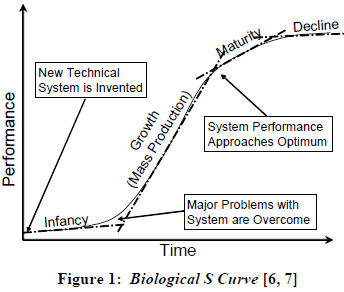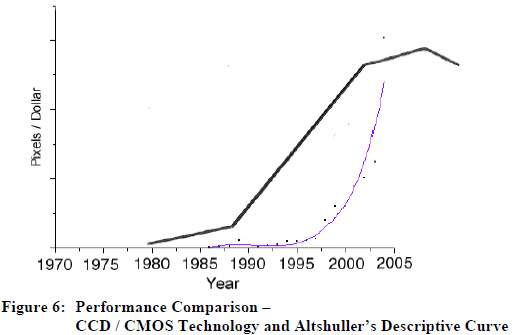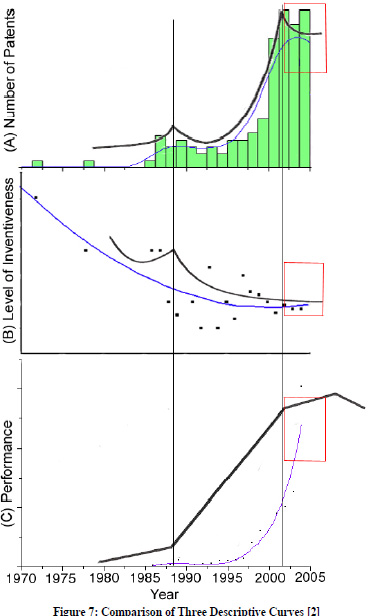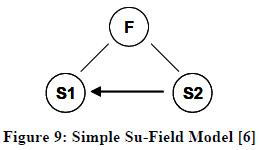Technology Forecasting of CCD and CMOS Digital Imaging Technology using TRIZ
Editor | On 14, Mar 2006
College of Textiles, North Carolina State University, Raleigh, USA
E-mail: timothy_clapp@ncsu.edu
Ina Parker, I.P. Discovery, Inc., Cary, USA
E-mail: iparker@ip-discovery.com
Abstract
CCD and CMOS image sensors, used in electronic devices such as digital cameras, have only recently become available to consumers. This paper describes a case study applying TRIZ to analyze the evolution of CCD and CMOS image sensors. TRIZ tools are used to determine the current state of the technology, and to predict its future development. TRIZ can be used to develop new, innovative product ideas resulting in an exemplary patent proposal, Smoke Detector Containing a Digital Imaging Device. With seamless expansion of technology forecasting into new product development, TRIZ can accelerate a company’s product development process as a whole and therefore help the company to maintain a leading edge against the competition.
Introduction
CCD (Charge Coupled Device) and CMOS (Complementary Metal Oxide Semiconductor) image sensors have been used commercially to capture digital images for over 20 years. The technology has become available and affordable to the consumer in electronic devices such as digital cameras or camera phones only recently [1] . This paper describes a case study in which TRIZ is applied to analyze the evolution of CCD and CMOS image sensors. The first goal is to determine the current state of CCD and CMOS technology, as well as to predict future developments in the technology and to deliver a long-term hypothesis where the technology is headed.
The second goal is to show how the TRIZ methodology can expand into innovative product development. Based on the evolution path predicted, TRIZ tools are used to execute new product development with CCD technology, resulting in a patentable new product idea.
TRIZ Background
TRIZ, the Theory of Inventive Problem Solving, is a methodology for problem solving and idea generation. TRIZ includes tools for problem identification, analysis, and solution, which can be applied to accelerate product development. TRIZ also offers systematic guidelines for technology forecasting [2] .
TRIZ was developed by Russian scientist Genrich Altshuller in the 1940’s. While working as a patent clerk, Altshuller identified patterns and similarities of patents in different technological areas. He discovered that problems, solutions, and patterns of evolution were repeated across industries [2] .
TRIZ provides tools to determine the status and the future of a specific product technology. The specific tools used in this case study are Maturity Mapping and System Approach [2, 3, 4] .
TRIZ also contains many tools that focus on problem solving during product development. Examples are the 40 Principles to solve contradictions, the concept of Ideality, and the Substance-Field Analysis [2, 3] .
A systematic TRIZ approach can accelerate a company’s product development process as a whole. A TRIZ analysis can help management to make decisions on how to pursue a particular product development task. Should product development focus on refining an existing technology, or should the company assign more resources to research in alternative, new technological areas?
CCD and CMOS Overview
Digitization has become the predominant method of information storage and transfer worldwide. This trend is evident in images as well. Digital cameras are developed on the same premises as CDs, DVDs, MP3s and other electronic devices. All of these devices utilize the conversion of analog information to digital information [5] .
Digital cameras differ from conventional cameras in that conventional cameras depend on a chemical process of light exposure to film. Digital cameras perform the same function with the use of image sensors, either CCDs or CMOSs. The image sensor consists of diodes that convert photons to electrons. Diodes are photo sites that store a specific level of electrical charge as a function of the light intensity received. Once the sensor has converted the light into an electrical charge, an Analog-to-Digital Converter, ADC, measures the electrical charge and converts it to binary information [5] .
The majority of digital cameras use CCD technology, while some use CMOS. The difference between CCD and CMOS is how the value of the electric charge of each cell in the image is read. In a CCD device, the light energy is transported across the chip, converted to a voltage, and read at one corner of the array. CMOS sensors perform the conversion from light energy to a voltage at the individual pixels sites, which is then read out. CCDs are more sensitive to light than CMOS, and create higher-quality, lower-noise images. CCDs have been mass produced for a longer period of time, so their quality has become more reliable. Most medium-to-high end cameras are based on CCDs. CMOS’ manufacturing cost and energy consumption are much lower than those of CCDs, making them the sensor of choice for lower-end digital cameras [5] .
Technology Evolution – TRIZ Maturity Mapping
Technology evolution follows the same Biological S Curve as seen in nature. Altshuller found that any system, biological or technological, goes through four stages: infancy, growth, maturity, and decline. The graph of the Biological S Curve developed by Altshuller is depicted in Figure 1. By determining the current state of a technology, future development can be anticipated [2, 6] .
In order to determine at which stage of the Biological S-Curve a current technology is
located, Altshuller developed four descriptive curves, as shown in Figure 2: (A) Number
of inventions or patents over time, (B) Level of inventiveness over time, (C) Performance
over time, and (D) Profitability over time. The dotted vertical lines in the graphs of
Figure 2 divide each of the curves into the four stages of the Biological S-Curve.
The infancy stage includes the initial concept and development to commercial viability of
a technology, and is characterized by a small number of highly innovative patents. Once
the product is on the market, the growth stage starts. As resources are focused on
stablizing commercial production quality, there is a slight lull in the number of patented
improvements. A significant increase in the number of patents follows as competitors try
to improve their individual products, hoping to gain an edge on the technology and the
favor of the consumer [2, 6] .
The performance graph (C) indicates that in the infancy stage, even slight increase in
actual performance can be achieved only with great effort of innovation. The focus of
development in this stage is to get the product running and out on the market. During the
growth stage, manufacturing cost, efficiency, and increased performance start to become
issues once the product is commercially available. In order to maintain competitiveness
in a rising market, price has to decrease and performance has to increase continually,
reflected by the steep rise in the performance graph during the growth stage.
Maturity Mapping of CCS and CMOS Technology
As a basis for the technology forecasting of CCD and CMOS image sensors, a
comprehensive patent search was conducted. Various combinations of search terms were
used. Initial searches were based on combinations of CCD, CMOS, Image Sensor,
Semiconductor, Pixel and Charge, resulting in a data base of approximately 150 patents
during the time frame of 1976 to present [8] .
Patents that truly contain a novelty relating to the CCD or CMOS sensor were identified.
It became apparent that the initial invention of the CCD sensor was patented earlier than
1976. In order to include relevant patents before 1976, patents were also analyzed and
traced back in terms of their references as well as their referred patents. As a result, a list
of 130 patents containing novelties in CCD and CMOS technology was compiled, as
attached in Appendix I.
The first criterion according to Altshuller’s descriptive curves for maturity mapping is
Number of Inventions Over Time. Figure 4 shows the accumulative Number of Patents
Over Time for CCD and CMOS technology. Individual data are depicted as histogram in
green columns. An averaged, smoothed curve of the data is shown as blue line. The
averaged cumulative curve fits almost perfectly to Altshuller’s corresponding descriptive
curve, which is overlaid as thick black curve. The number of inventions in CCD and
CMOS technology peaked around 2002 –2003. The industry has already started to see a
decline in the number of inventions related to CCD and CMOS imaging chips.
In order to generate the descriptive graph for Level of Inventiveness, the patents were assessed quantitatively based on Altshuller’s Five Levels of Inventiveness. Each patent was analyzed in terms of five different criteria:
A) Field of invention vs. field of problem
B) Solution mechanism
C) Characteristics of the system
D) Effects or principles leading to the invention
E) Existence of contradictions
Each criterion is categorized at a level between one and five, five being the most inventive. The final rating of inventiveness or innovation rating as plotted in Figure 5 is calculated as the average of the rating in each category. A concise table depicting the rating criteria is attached as Appendix II.
The individual points in Figure 6 show the average rating of all patents filed in each year. The continuous graph depicts the smoothed accumulative average of the innovation level of all patents analyzed.
By overlaying the graph that results from the patent search for CCD / CMOS technology with Altshuller’s corresponding descriptive curve, it can be seen that the plot most closely matches the area of the curve towards the end of the evolutionary cycle. This is in accordance with the findings for Number of Patents Over Time, showing that the evolution of CCD and CMOS technology is nearing the end of its evolution.
Altshuller’s third descriptive evolutionary curve characterizes the technology’s performance. As objective, measurable performance characteristic for CCDs, the number of pixels per US Dollar was chosen. Data is available from 1986 until 2004 [1] . The number of pixels has increased and the price has decreased exponentially over the past twenty years, as depicted in Figure 6. Overlaying the graph with Altshuller’s descriptive curve for Performance Over Time shows a fit of the curve starting in the infancy stage to the end of the growth phase.
Figure 7 shows the alignment of all three descriptive curves according to the evolutionary stages defined by Altshuller. The red boxes mark the part of the curves corresponding to the current state of the technology, from year 2000 to present. This comparison shows that CCD and CMOS technology is in the mature stage of its evolution.
While economic success can still be achieved by optimizing existing components and systems, and cutting manufacturing cost by streamlining existing production processes, profit margins will erode. Efforts and resources must be focused on developing new technology, and independent, new components, products and systems, in order to maintain a leading edge against the competition. Based on these findings, the following sections of this paper describe an approach to new product development using TRIZ tools.
Development of the Digital Imaging Chip – TRIZ System Matrix
With the extensive patent search, a comprehensive knowledge of CCD and CMOS technology, including its benefits and drawbacks, was gained. After determining the mature status of the technology, TRIZ analysis was seamlessly expanded into new product development. A good tool to start product development by gaining an overview of potential paths is the TRIZ System Matrix. The technology is visualized in a three-bythree matrix, with different time levels in the horizontal direction, and different detail levels in the vertical direction. The three time levels analyzed are past, present and future, while the three different detail levels are labeled as Supersystem, System, and Subsystem [4] .
The System Matrix is of practical help to the development engineer because it forces questions like:
• What parts are missing, or what are the challenges to be overcome to make an ideal System (= perfect imaging sensor) or ideal Supersystem (= perfect camera)?
• Which are the Subsystems holding back new development, and what are their shortcomings?
• What were parts and characteristics of CCDs and CMOS in the past, what are the current parts and characteristics, and what are possible parts and desirable characteristic relevant for the future?
• What are desirable characteristics of the camera as Supersystem, how could the CCD or CMOS contribute to achieve these, or what would an alternative sensor need to be like to make a better camera?
• Are there other Supersystems that could use CCD or CMOS?
The TRIZ System Matrix for CCD or CMOS imaging sensors is shown in Figure 8. It can be seen that at all three detail levels, future development is focused on faster performance, lower price and better quality. This means that components of CCD or CMOS sensors as well as the Supersystem Camera are at the same maturity level as the sensors themselves.
In the following case study for a new, innovative product development, CCD technology is applied in a novel Supersystem – the Smoke Detector.
New Product Development for the Digital Imaging Chip using TRIZ
The following sections of this paper illustrate how TRIZ tools can be used to aid the development process, starting with an innovative idea, and resulting in a patentable product solution. The innovative product to be developed is a Smoke Detector containing a CCD image sensor.
TRIZ Ideality
One TRIZ tool suitable for product development is the concept of Ideality. The desire is to create the best system possible – the Ideal System. An Ideal System provides the desired function without any harmful effects or drawbacks. The degree of ideality in the TRIZ sense is a measure of how good a systems or product solution is. TRIZ Ideality is defined as
Useful Effects are features and functions that improve the product, its performance, quality, reliability etc. Harmful Effects include cost, pollution, energy consumed, etc.
In the case of the Smoke Detector, the existing system is a detector installed in a room that triggers an acoustical or remote alarm if smoke particles are detected in the air. The useful functions of the existing system are
a) detection of smoke particles in the air and
b) triggering alarm.
A potential harmful effect of the existing system is false alarm (e.g. smoke detector is triggered by cooking fumes).
In order to develop the existing system towards an Ideal System, the useful functions can be increased:
a) detection of smoke particles in the air, complemented by a visual image of where and how dense the smoke is in the room
b) delivery of a visual image of the room to aid fire extinction and rescue (determine
if and where people are trapped, assess condition of the room, locate safe entry ways to better prepare rescue personnel and to increase their safety)
c) delivery of a visual image to find the source and root cause of the smoke/fire (could be used for developing better security measures for appliances, for insurance purposes etc.)
By implementing an image sensor in the smoke detector, harmful effects could also be reduced:
a) reduction of false alarms triggered (if smoke is detected, the room can be searched visually for false triggers such as cooking fumes)
b) reduction of risk of physical harm to rescue personnel / firefighters (firefighers know what to expect before they get into the room, they are better prepared to avoid injury, and don’t need to waste valuable time searching for entry ways or victims to be rescued)
The key to develop a system towards Ideality is to add new functions and reduce harmful effects by utilizing existing resources, such as the materials and fields of the system itself.
In the case of the smoke detector, the existing field that is available as resource and has not been used with conventional smoke detectors is the visual image of the room. Using CCD technology, this system resource can be exploited to add additional functionality to the smoke detector. Implementing CCD and digital camera technology into the smoke detector will allow an image of the room to be captured without a person being present in the room.
TRIZ Substance-Field Analysis
Substance-Field (Su-Field) Analysis is another TRIZ tool that can be applied to new product development. Su-Field Analysis visualizes systems and the relationship between their substances, fields, functions and objectives in a simple graphic. Substances in the TRIZ sense represent objects that have a function. A generic Su-Field Model is shown in Figure 9.
The object S2 is acting upon the object S1 through the field F. F can represent a variety of measures, such as energy fields, chemical reactions, or physical effects. S1 is the object that delivers the desired function of the system. Su-Field Analysis is helpful in visualizing, detecting, and repairing an incomplete system, an ineffective system, or a complete system that create harmful effects [6] .
In order to improve the system Smoke Detector using Su-Field Analysis, the basic problem was identified as the system being ineffective. Conventional smoke detectors only trigger a smoke alarm. They are missing essential functions to help fire extinction or rescue, since they do not render any information about the actual situation of the place where the smoke particles are detected.
As first step in the Su-Field Analysis, elements of the existing system were identified:
Object S1: Smoke Detector
System Function to be delivered by Object S1:
Provide reliable smoke alarm and image of the place where smoke is detected
Object S2 acting on Object S1:
Smoke Particles
Field F: Electrical field – Smoke is detected by a) ionization of air particles
or b) photoelectric analysis of air samples [9] .
The second step is to construct the Su-Field Model, as shown in Figure 10.
The dashed arrow indicates an incomplete desired effect, resulting in the system function delivered by the smoke detector to be ineffective. The smoke detector only alarms when smoke is in the room, but does not give any information about the severity or kind of situation. To resolve the incomplete desired effect, another field available in the system can be exploited by introducing an additional Object S3, Visual Image. The improved, complete system is shown in Figure 11.
Since the system now provides the desired effect, the analysis is complete. If the system were still ineffective, other TRIZ tools, such as Contradiction Matrix or Many Little People Modeling could be used to generate further innovative solution ideas.
New Product Development – Patent Proposal Example
In order to secure the results of innovative product development, and to prepare the product for commercial success, the rights to the product must be established. One way to successfully complete the product development is to obtain a patent on the innovative product. The following section gives an example how a patent could be written as a result of product development using TRIZ.
Smoke Detector Containing a Digital Imaging Device
ABSTRACT
The claim of this invention is a smoke detector, which contains a CCD or CMOS digital imaging chip, along with a panoramic lens facilitating the most comprehensive view of the room in which the detector is placed. Also claimed is an infrastructure, which allows the smoke detector to be either wire- or wirelessly-connected to an external monitor.
BACKGROUND OF THE INVENTION
The invention described below incorporates a standard smoke detector. Smoke detectors are used to detect the presence of fire, alerting the inhabitant to extinguish the fire or leave the premises. Smoke detectors are able to sense multiple types of smoke, and emit an audible and/or visible alarm if smoke is detected. Typical smoke detectors use either ionic or photoelectric effects to detect smoke particles in the surrounding air [9] .
Usually, the sensitivity of the smoke detector to particle size, frequency and type is adjustable. One problem with these existing systems is that, depending on the chosen sensitivity, false alarms may be triggered, or smoke or fire may be detected at a delayed time. Furthermore, these conventional devices do not allow for any assessment of the situation before a human actually enters the problem area.
CCD and CMOS chips are used in digital imaging applications, from high resolution digital cameras, to low resolution cameras in cellular phones. Low resolution color or black and white chips are cheap and easy to obtain. CCD and CMOS chips contain an array of photodiodes, each representing a pixel, and supporting circuitry to convert the analog signals from the photodiodes into a digital image.
There is need for a smoke detector that provides a simple way to detect fire and smoke, then assess the situation and potential danger in the specific area. The alarm triggered by the detector needs to allow for instant assessment of the condition of the room, in order to insure maximum safety of persons on the premises.
SUMMARY OF INVENTION
The present invention incorporates an image sensor with a smoke detector, allowing the room to be previewed to assess danger and the presence of victims. The image sensor uses CCD or CMOS imaging technology, and a panoramic lens, allowing the most complete view of the room. There will be either a wireless or wired infrastructure facilitating connectivity to emergency personnel.
The smoke detector will also incorporate a visible signal, in the form of a strobe. This will serve to illuminate the room, ensuring a properly lighted image. The smoke detectors will be installed in the places smoke detectors are typically installed. With a unit in each room, emergency personnel will be able to quickly scan through the building and determine where victims are trapped, and what areas are safe enough to attempt rescue.
Conclusions
By means of a case study, it was shown how TRIZ can be used to determine the evolutionary status of a specific technology, and how TRIZ can then help to accelerate new product development based on the maturity status determined.
Digital imaging technology using CCD and CMOS chips was analyzed, and the maturity of the technology was mapped in the areas of Number of Patents per Year, Inventiveness of the patents, and Performance. In all areas, the technology is in the mature stage and nearing the end of its evolutionary cycle. While there is still room for optimization and improvements in existing technology, companies must focus on developing new technologies, and advance new technologies for commercialization. One way to keep an edge against the competition, and to compensate for the declining economic success of the existing mature technology, is to find innovative, new Supersystems where the existing technology has not yet been applied, and can be of major advantage.
This paper shows how the TRIZ analysis can lead to innovative product development, resulting in a patent in a new technological field, which will allow for continued commercial success of the existing mature technology of CCD and CMOS.
References
[1] Carter, R.L.
[2] G.S. Altshuller: Creativity as an Exact Science. Gordon and Breach Publishers, 1984.
[3] Terninko, John, Alla Zusman and Boris Zlotin. Systematic Innovation: An Introduction to TRIZ. St. Lucie Press: 1998.
[4] North Carolina State University, Graduate Course: Theory of Inventive Problem Solving, Spring 1999, Course Notes provided by Ideation International.
[5] Nice, Karim, and Gerald Gurevich. “How Digital Cameras Work†20 April 2005.
[6] Terninko, John; Zusman, Alla; Zlotin, Boris: STEP-by-STEP TRIZ: Creating Innovative Solution Concepts. 1996 Responsible Management Inc.
[7] Mueller, Gernot: Accurately And Rapidly Predicting Next-Generation Product Breakthroughs In The Medical-Devices, Disposable Shaving Systems, And Cosmetic Industries. https://the-trizjournal.com, TRIZ Journal, March 1999.
[8] United States Patent Office,
[9] FireNet, University of Texas,
http://www.me.utexas.edu/~ezekoye/rsch.dir/firesite/smoke_detector.html












